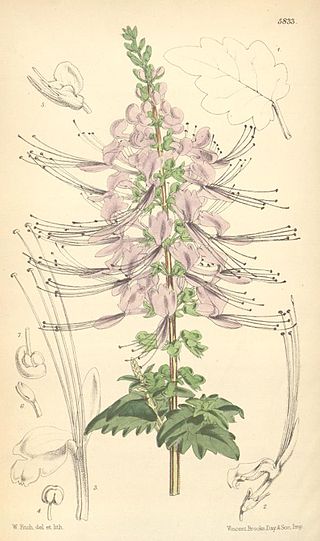
Chaetocarpus is a plant genus of the family Peraceae, formerly Euphorbiaceae, first described as a genus in 1854. Chaetocarpus species are trees or shrubs. They are native to the Americas, Africa, and Asia. Some species are endangered.
- Chaetocarpus acutifolius(Britton & P.Wilson) Borhidi – Sierra de Moa in Cuba
- Chaetocarpus africanusPax – C Africa
- Chaetocarpus castanocarpus(Roxb.) Thwaites – SE Asia, Yunnan, Assam, Bangladesh, Sri Lanka
- Chaetocarpus cordifolius(Urb.) Borhidi – Cuba, Hispaniola, Jamaica
- Chaetocarpus coriaceusThwaites – Sri Lanka
- Chaetocarpus cubensisFawc. & Rendle – Cuba
- Chaetocarpus echinocarpus (Baill.) Ducke – Bolivia, Brazil
- Chaetocarpus ferrugineusPhilcox – Sri Lanka
- Chaetocarpus gabonensisBreteler – Gabon
- Chaetocarpus globosus(Sw.) Fawc. & Rendle – Jamaica, Cuba, Dominican Rep.
- Chaetocarpus myrsinitesBaill. – Bolivia, Brazil
- Chaetocarpus parvifoliusBorhidi – Cuba
- Chaetocarpus pearceiRusby – Bolivia
- Chaetocarpus pubescens(Thwaites) Hook.f. – Sri Lanka
- Chaetocarpus rabarabaCapuron – Madagascar
- Chaetocarpus schomburgkianus(Kuntze) Pax & K.Hoffm. – Colombia, Venezuela, 3 Guianas, NW Brazil

Orthosiphon is a genus of plants in the family Lamiaceae native to Africa, Southern Asia and Queensland, with one species (O. americanus) in Colombia. They are herbaceous shrubs which grow to a height of 1.5 m (5 ft). Some Orthosiphon species are popular garden plants because of their flowers, which are white and bluish with filaments resembling a cat's whiskers. In the wild, the plants can be seen growing in forests and along roadsides.

The tawny nurse shark is a species of carpet shark in the family Ginglymostomatidae, and the only extant member of the genus Nebrius.
The Rio de Janeiro arboreal rat is a rodent species from South America. It is found in Brazil. It is the only species in the genus Phaenomys.

The rusty pitohui is a species of bird in the family Pachycephalidae. It is found throughout the lowlands of the Aru Islands and New Guinea.

The southern boubou is a bushshrike. Though these passerine birds and their relations were once included with true shrikes in the Laniidae, they are not closely related to that family.

The palm weevil Rhynchophorus ferrugineus is one of two species of snout beetle known as the red palm weevil, Asian palm weevil or sago palm weevil. The adult beetles are relatively large, ranging between 2 and 4 centimetres long, and are usually a rusty red colour—but many colour variants exist and have often been classified as different species. Weevil larvae can excavate holes in the trunks of palm trees up to 1 metre (3.3 ft) long, thereby weakening and eventually killing the host plant. As a result, the weevil is considered a major pest in palm plantations, including the coconut palm, date palm and oil palm.

The austral parakeet, austral conure, or emerald parakeet is a species of bird in subfamily Arinae of the family Psittacidae, the African and New World parrots. It is found in Argentina, Chile, and possibly the Falkland Islands.
Hyperolius ferrugineus is a species of frog in the family Hyperoliidae. It is endemic to Democratic Republic of the Congo. Its natural habitats are subtropical or tropical moist lowland forests, swamps, freshwater marshes, and intermittent freshwater marshes.

The Cocos cuckoo is a Vulnerable species of bird in the tribe Phaenicophaeini, subfamily Cuculinae of the cuckoo family Cuculidae. It is endemic to Cocos Island, an island in the Pacific Ocean which is part of Costa Rica.

The ferruginous-backed antbird is a species of passerine bird in the family Thamnophilidae. It inhabits the Guyanas and the northern Amazon Basin. Its natural habitat is subtropical or tropical moist lowland forests.
Deronectes ferrugineus is a species of beetle in family Dytiscidae. It is endemic to Portugal.
Andrewsianthus ferrugineus is a species of liverworts in the family Lophoziaceae. It is found in Bhutan and Nepal. It grows on tree trunks in forests. It is threatened by deforestation. According to the IUCN Red List of Threatened Species, its status is endangered.

Ozothamnus ferrugineus, commonly known as tree everlasting, is a member of the genus Ozothamnus, of the Asteraceae family – one of the largest families of flowering plants in Australia. Native to the Australian states of New South Wales, Victoria, South Australia, and Tasmania, it forms an erect shrub or small tree between 2 and 3 metres in height.

The rusty parrotfish is a species of marine ray-finned fish, a parrotfish belonging to the family Scaridae. It is associated with reefs in the north western Indian Ocean and the Red Sea.
Procambarus liberorum is a species of crayfish in the family Cambaridae. It is endemic to the United States, where it occurs in Arkansas and Oklahoma. It is known commonly as the Osage burrowing crayfish.

Beesoniidae is a family of scale insects commonly known as beesoniids. They typically cause galls on their plant hosts. Members of this family mostly come from southern Asia. The family name comes from the type genus Beesonia which is named after the entomologist C.F.C. Beeson who obtained the specimens from which they were described and named.
Croton ferrugineus, synonym Croton elegans, is a flowering plant species in the family Euphorbiaceae native from western South America to northern Brazil.

The palm weevil Rhynchophorus vulneratus is one of two species of snout beetle known as the red palm weevil, Asian palm weevil, or Sago palm weevil. The adult beetles are relatively large, ranging between 2 and 4 centimetres long, and vary from a rusty red colour to almost entirely black; many colour variants exist and have led to considerable confusion with other species. Weevil larvae of these species can excavate holes in the trunk of a palm tree up to 1 metre long, thereby weakening and eventually killing the host plant. As a result, these weevils are considered major pests in palm plantations, including the coconut palm, date palm and oil palm.













